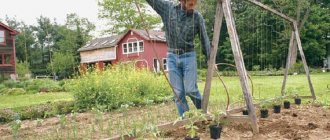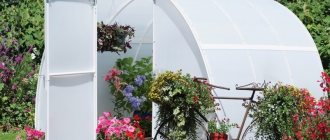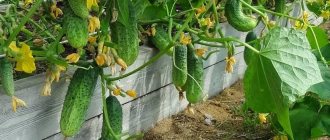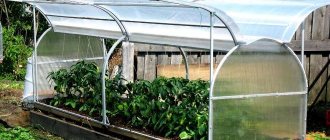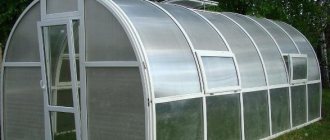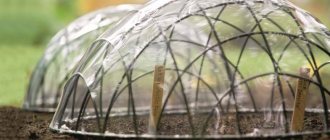You can get a rich harvest of cucumbers only with proper care. It consists not only of regular watering and fertilizing, but also of the correct formation of the cucumber vine. It should be juicy and well developed. The trellis method allows you to achieve this state. Growing cucumbers on a trellis in open ground is what is needed for good vine growth. On such devices, the vegetable crop develops quickly and produces a large harvest in the shortest possible time.
Growing cucumbers on a trellis in open ground
Features of the use of trellis structures
Cucumber is a climbing plant of the Cucurbitaceae family, the length of its lashes can reach up to 2 m. The tendrils help it cling to everything that comes in its way. But they alone are not enough if you want to reap abundant harvests from this crop.
The best solution is special supports for cucumbers. Tying them to them allows you to provide the plant with the highest level of illumination. And this, in turn, helps to increase the number of ovaries and accelerate the formation of fruits.
Vertical tying of cucumbers to a support: description of the method
In this case, two supports must be placed on opposite edges of the bed, and at the very top, a rope must be pulled between them. We tie fabric strips 2-3 cm wide along the entire length of the stretched cable and lower them down. Their number should be equal to the number of bushes that need support. We tie the bottom end of the fabric around the base of the cucumber.
As a result, the plant will independently cling to the support and stretch upward along it. This method makes it possible to place a large number of cucumber bushes in a small area. Instead of fabric strips, sticks are often used, placed near each plant. You can also make a triangle of three supports, and stretch ropes between them and hang support strips.
Advantages of growing on a trellis
It has been scientifically proven that growing cucumbers on supports specially made for this purpose is more preferable than spread out, since with a vertical arrangement the plant can completely get rid of bacteria accumulated in the soil over the winter. And even if the infection gets on the lower leaves along with water, it will not spread, but will evaporate with the moisture.
As trellis structures, you can use vertical surfaces that already exist on the site - building walls, pillars, fencing.
A do-it-yourself trellis for cucumbers can also be used when growing in a greenhouse. Such a solution brings with it a lot of advantages. It:
- saves land area;
- reduces the risk that the plant will get sick;
- accelerates the growing season;
- increases productivity;
- simplifies care and harvesting;
- facilitates movement between beds;
- prevents creases and damage to stems;
- allows you to collect clean fruits.
This cultivation method is also good because when ripe cucumbers are picked, the small thorns located on the stems injure the skin of the hands significantly less.
How to tie cucumbers in a greenhouse with your own hands: options for tying plants
It is necessary to tie cucumbers in a greenhouse, although many believe that the plants are reliably protected by the greenhouse material. Thanks to the garter, cucumbers receive more sunlight, which is especially important in greenhouse conditions.
In addition, with the help of tendrils, plants cling to each other and form balls. Mold grows in these weaves and the bushes begin to rot. This can be avoided by separating the plants. The garter allows for better development of the side branches on which the female flowers are located. This arrangement allows you to increase the yield of bushes.
The same methods are suitable for gartering in a greenhouse as for plants outside: horizontal, vertical and using a net. No less effective is the formation of plants using a combined method.
Tying cucumbers makes it possible to grow more plants in a small area.
Method of blinding cucumbers. Experienced gardeners believe that the plant should not grow uncontrollably in height and width. To do this, the main stem must be tied to a vertical support, and then all side shoots and tendrils that are located above 50 cm from the soil must be removed. Thanks to this, the cucumber will direct all its efforts to setting fruit on the main stem. The bush itself will hurt less and will not be able to block neighboring shoots. You need to tie the plant under the second leaf.
Method for polycarbonate greenhouses. A tie is used to a vertical trellis about 2 m high. The structure is attached to the side of the metal frame of the greenhouse. To make a support, you can use unnecessary fabric, cutting it into strips 2-4 cm wide. If the strips are not long enough, then this defect can be corrected by sewing individual parts or simply tying them. Such a trellis is short-lived. Instead of fabric, you can take thin twigs. Cucumber bushes cling to them well, but you will need to clear the support of knots, leaving only the main stem.
V-shaped garter. This option allows you to divide the bush in two. You should lower two twines from above and tie the cucumber at the base. After this, you need to direct the main and one large side shoot along the lowered twines and allow the plant to cling to them. This method prevents the base of the plant from becoming overgrown, so it gets sick less and receives the necessary amount of sunlight.
Scheme of garter and stem formation of a cucumber.
Rectangular trellis
The main elements are support posts and mesh. The first can be made of metal, wood, concrete, and the second can be made of metal wire, hemp rope, twine, plastic.
The mesh must be attached to the posts along the upper edge, and the lower end must be buried in the soil, pressed with tin hooks.
Types of supports
Most gardeners approach the creation of trellises for cucumbers creatively. They use different materials, creating complex or very simple designs from improvised materials.
Varieties of trellises for cucumbers according to shape:
- rectangular;
- hut type;
- round;
- arched;
- on a stretched mesh between supports;
- horizontal - the stems are partially raised up and laid on openwork supports, for example, a ladder.
Note that the main problem with permanent trellises is the need to grow cucumbers for a long time in one place. In this case, it is necessary to update the soil annually and fertilize especially carefully.
Non-permanent trellises for cucumbers, for example, on a tire, can be easily moved to a new location every year.
Round and arched designs
They are more difficult to implement. Creating an arch is especially difficult, but it looks incredibly beautiful.
The choice of a specific option depends on the amount of square meters of land allocated for supports, the selected material of manufacture and personal preferences.
Principles of planting cucumbers when growing trellises
There are two ways to plant cucumbers under trellises - by seedling method and by direct sowing. In both cases, loose fertile soil with neutral or low acidity is used for planting. But each method has its own nuances.
Table 2. Principles of different methods of planting cucumbers.
| Landing option | Nuances |
| Transferring seedlings to open ground | In this case, the harvest can be harvested much earlier. 1) Young seedlings are grown indoors in the usual way. 2) Sprouts ready for transfer have 3 true leaves, they reach a height of 15-20 cm. Cucumbers should be replanted in late spring, when the risk of night frosts decreases. |
| Seeding | 1) Planting material must be heated at a temperature of 50-60 degrees for 3 hours, then soaked in a pink solution of potassium permanganate for 20-30 minutes. 2) Seeds are placed in the ground when the top layer of soil warms up to +15 degrees. There are 3-4 seeds per meter of bed. 3) To speed up ripening, the crops are covered with film. The covering is removed when 5-6 fresh leaves appear on each growth. |
The soil under cucumbers must be kept moist, since cucumbers are very moisture-loving. The growing shoots are watered every 4-5 days. From 3 to 6 liters of water should be used per square meter of bed.
How to make a wooden cucumber stand yourself
It will take approximately two hours to make. The support should be erected after planting the seeds, but before the first shoots appear.
Here are instructions on how to make a support for cucumbers:
- Decide on the type of structure.
- Install the pillars, maintaining a distance of 1.5-2 m.
- Secure the supports at an angle of 70 degrees and anchor them with guy wires.
- Build a frame by nailing a horizontal cross member to the top of the support posts.
- Perform the sheathing. It is best to use thin slats 30 mm thick for this. The optimal cell size for cucumbers is 15*15 cm.
To build a trellis for cucumbers in open ground, experts advise choosing hardwood - chestnut, oak, ash, mulberry.
You should not use birch or poplar wood - it rots quickly. To extend the life of a wooden support, before burying it in the ground, the bars should be covered with two layers of drying oil or treated with an antiseptic.
If properly designed, a cucumber trellis can adequately decorate your site, acting as a non-standard element of landscape design. Therefore, there is no need to spare time and effort on its construction.
How to install the system on site?
As a rule, most gardeners opt for a standard design. To create it, scrap materials that are unnecessary on the farm are often used. They will not look as aesthetically pleasing as more modern trellises, but they will be very functional.
Classic trellises are placed on a ready-made bed, taking into account the following recommendations:
- The supports are dug in the center of the bed in one longitudinal line. There remains a distance of 4-5 meters between the pillars.
- From support to support, stretch the wire in 3 rows one below the other. If the mesh will not be attached to the wire, the supports should be installed in smaller increments.
- A metal mesh with 15x15 cm squares is tied to the wire and supports. To prevent the mesh from sagging, the top wire can be replaced with a wooden lath or a metal stick. This will add rigidity to the structure.
Metal mesh on supports
This is just a classic variation of the device. Thanks to the resourcefulness of gardeners, a lot of other, no less functional manufacturing methods have appeared.
Installation of a classic design
Prices for metal mesh
metal grid
Making different types of trellises
Trellis are quite easy to make. Among the variety of methods, the simplest is considered to be the manufacture of a wooden structure. It is the easiest to assemble, and the slats connect as quickly as possible. At the same time, it takes up very little space.
Wooden structure
When creating a wooden frame, you need to consider that:
- wooden posts made of pine are suitable as support;
- the outermost pillars must have a cut diameter of at least 5 cm and a length of 2.8 m, since they will bear the entire load;
- intermediate support pillars can be 40-50 cm shorter, cut diameter - 3.5-4 cm;
- The step for installing additional supports depends on the length of the bed: if it is shorter than 3 m, auxiliary posts may not be useful.
The table below shows the easiest types of trellis to make. At the same time, the designs are very reliable and tested by dozens of gardeners.
Table 1. Design options for trellises.
| Design Variation | What you will need | How to make | Photo |
| U-shaped system | — a frame in the shape of the letter P made of wooden slats or iron pipes; - strong twine. | 1) The U-shaped frame is installed on the bed similarly to the classic design. For greater stability, the distance between the posts should be up to 3 m. 2) The standard length of the posts is 2.5 meters, but the final figure depends on the variety of cucumbers. 3) Strong strands of twine are thrown over the top crossbar and secured on both sides of the bed. The threads must be placed at a distance of 15-20 cm from each other. The cucumbers will grow and grab the twine with their antennae, thereby stretching upward. | |
| Frame made of wooden sticks | - iron or pine poles for support; - thin wooden slats. | 1) From long wooden slats you need to put together a lattice with windows 15x15 cm. The slats are attached to each other using self-tapping screws. 2) Supports are installed on the bed according to the standard scheme. 3) The grille is attached to the supports. | |
| From scrap materials | - 2 wooden posts; - metal grid. You can use a frame from an old bed with armored mesh. | The pillars are installed at the end and beginning of the bed, and a mesh is stretched between them. There is an inconvenience in this method: under the weight of the cucumbers, the mesh sags greatly. In this case, it can tear or destroy the entire structure. To avoid this, the mesh is pulled up, securing it to a wooden lintel between the posts. The pillars are installed at the end and beginning of the bed, and a mesh is stretched between them. There is an inconvenience in this method: under the weight of the cucumbers, the mesh sags greatly. In this case, it can tear or destroy the entire structure. To avoid this, the mesh is pulled up, securing it to a wooden lintel between the posts. If an old bed frame is used as a trellis, it is placed vertically and deepened by 60 cm. To be on the safe side, the frame is tied to the supports. They can be the walls of a house or strong trees. | |
| Hut construction | - several straight branches from a strong tree or wooden slats; - boards or slate for fixing the structure; - strong rope. | 1) The branches are stuck into the ground in the garden bed according to the principle of a hut structure. 2) They need to be deepened by at least 30-40 cm. 3) The branches that are opposite each other are tightly tied with a rope at the top. 4) A wooden strip is laid along the bed on the tied branches to secure the structure. | |
| Round trellis | - old bicycle wheels; - straight wooden sticks or metal rods. | 1) Wheels are placed on the stick from different sides so that it comes out from the center. 2) The wheels are secured to the support using screws. 3) Vertical threads are pulled between the upper and lower wheels. They can be attached to the spokes or the rim. The finished structure is installed in a convenient location. You can make as many of them as you like. |
If you don’t have time to design trellises yourself, you can go to a specialized gardening store. They sell convenient ready-made structures of various shapes and sizes. As a rule, they are easy to install and remove for the winter.
Important! The supports at the beginning and end of the ridge should be much stronger than the additional ones. After all, it is they who will bear the entire burden during the ripening of the crop. Even if you plan to create a wooden structure, it is recommended to use reinforced concrete pipes as outer supports.
Photo trellises for cucumbers
Metal structure
And the strongest support is made of metal tubes (photo 2).
To build it, you need some tools and materials:
- 2 two-meter metal pipes or poles;
- 1 pipe for the crossbar, equal to the length of the bed;
- metal pegs (their number also depends on the length of the bed);
- construction tape;
- leg-split;
- knife;
- electric welding and electrodes;
- shovel;
- hammer;
- wire.
Here's how to make a metal trellis.
- First, dig in 2 pillars at opposite edges of the bed.
- The depth of the holes for their installation is 40 cm. But for stability, they are additionally driven into the ground with a hammer another 25 cm.
- Having filled the holes, the soil is compacted.
- Now a horizontal crossbar is secured on top of the pillars by electric welding.
- Pegs are placed on the sides of the bed every 20 cm.
And then they pull the twine for the curly cucumber trunks. The technology for stretching it is simple: the edge of a skein of twine is tied to the outermost peg. Then - up to the crossbar, wrap it and lower it to the opposite peg, securing it with a knot. All pegs are connected in the same way, creating a trellis “L”. Twine is often replaced with wire. When the cucumbers on the trellis wrap around the twine, the support will turn into a green tent.
Advice! To prevent rust from damaging metal pipes, they are primed or treated with some kind of anti-corrosion compound.

